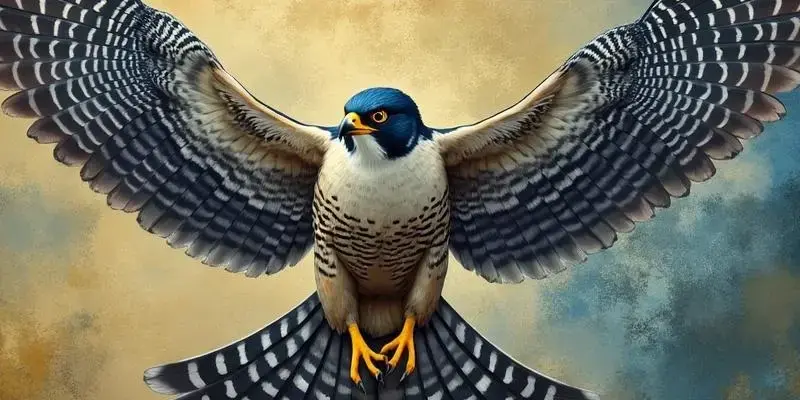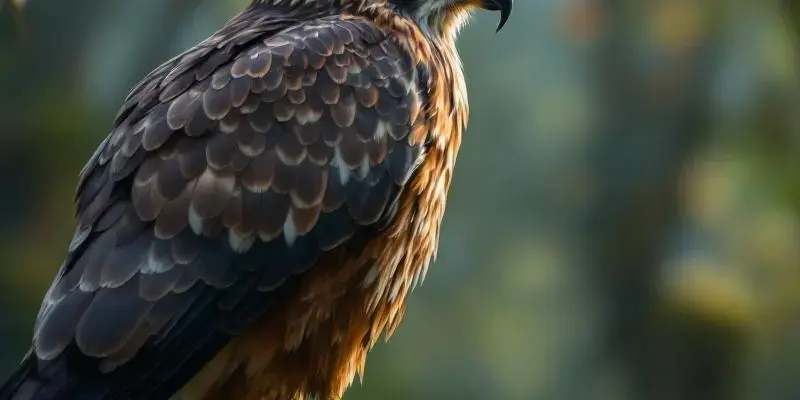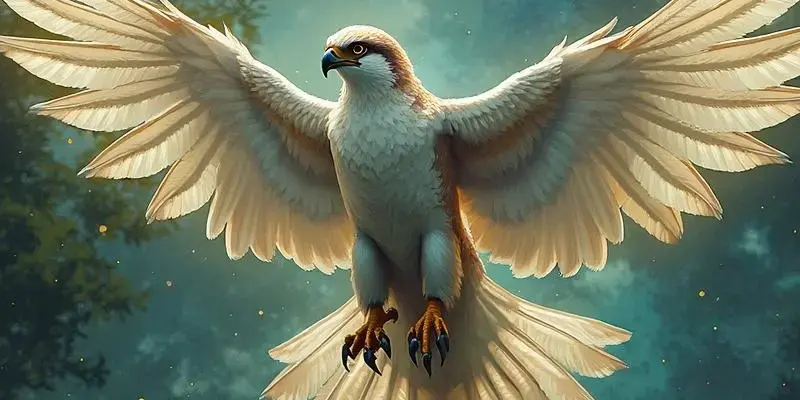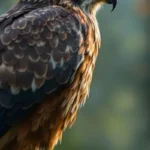Peregrine-falcon spiritual meaning

Peregrine falcons, recognized as the fastest birds on earth, embody profound spiritual symbolism across diverse cultures and traditions. Their remarkable speed, vision, and migratory journeys have established them as powerful symbols of transformation, divine connection, and focused determination in spiritual traditions spanning continents and centuries.
Key Takeaways
- Peregrine falcons symbolize the perfect balance between speed and precision, reaching over 200 mph during hunting dives
- Their name derives from Latin roots meaning “pilgrim” or “wanderer,” highlighting their connection to sacred journeying and spiritual transformation
- Native American traditions revere the falcon as a messenger between worlds, connecting heavenly and earthly realms
- Ancient Egyptian culture associated falcons with divine kingship through Horus and Ra, emphasizing protection and cosmic order
- As a spirit animal, the peregrine represents focused determination, mental clarity, and the ability to achieve ambitious goals
The Sky’s Ultimate Messenger: Introduction to Peregrine Spirit
The peregrine falcon stands as nature’s ultimate embodiment of speed and precision. As Earth’s fastest animal, it reaches astonishing velocities exceeding 200 mph during its hunting stoop—a near-vertical dive that showcases both deadly accuracy and perfect control. Its scientific name, Falco peregrinus, translates to “pilgrim falcon” in Medieval Latin, highlighting its wandering nature.
These remarkable birds maintain a global presence across all continents except Antarctica, undertaking incredible migration journeys that can span up to 20,000 miles annually. Their exceptional vision, approximately eight times more acute than human sight, allows them to spot prey from nearly two miles away. This combination of speed, vision, and journeying forms the foundation of their rich spiritual symbolism.
The peregrine’s recovery story adds another spiritual dimension to their significance. Having faced near extinction due to DDT pesticides in the mid-20th century, which reduced North American populations by 90%, their remarkable comeback represents resilience and renewal. This journey from the brink of disappearance to thriving populations mirrors the transformative qualities they symbolize in spiritual traditions.
Sacred Speed: The Etymology of “Peregrine”
The peregrine falcon’s spiritual significance begins with its very name. Derived from the Latin “peragrare” meaning “to travel through” or “wanderer,” the term reflects the bird’s migratory nature and connects it to the concept of sacred journeying. Medieval falconers designated it as “falco peregrinus” (pilgrim falcon), creating an explicit link between these birds and religious pilgrimage.
This linguistic connection threads through Romance languages—appearing as “peregrino” in Spanish and “pèlerin” in French—consistently maintaining the pilgrim association. Historical falconry texts distinguished between “peregrinus” (migratory) and “calidus” (resident) birds, with the peregrine’s wandering nature considered a sign of superior spirit and adaptability.
The peregrine’s physical journey mirrors the spiritual concept of pilgrimage found in many traditions. Their annual migrations spanning up to 20,000 miles symbolize the transformative power of sacred journeys. Like human pilgrims who return changed from their travels, the peregrine’s cyclical movement represents protection, rebirth, and renewal through purposeful wandering.
Messengers Between Worlds: Native American Falcon Symbolism
In Native American traditions, particularly among Mississippi River cultures like the Pascagoula, Cahokia, Choctaw, and Chickasaw, the peregrine falcon occupied a revered position as messenger between realms. Archaeological evidence at Cahokia Mounds reveals shell bead burial beds shaped as falcons, highlighting their spiritual significance dating back centuries.
The mythological “Birdman” figure, depicted on the famous Rogan Plates discovered at Etowah, represents a spiritual intermediary with falcon characteristics. This figure embodied the falcon’s ability to move between the heavenly and earthly domains, carrying messages between humans and deities. The peregrine’s association with the sun, sky, and light connected it to higher spiritual order in these traditions.
Beyond their messenger role, falcons held significance in warfare symbolism, believed to bring luck and victory in battle. Ceremonial practices often featured falcon feathers and costumes in sacred dances, while the birds themselves were considered protective guardians against malevolent underworld spirits. This protective aspect shares similarities with the eagle’s spiritual significance in many indigenous traditions, though the falcon’s swiftness adds a distinctive dimension.
Divine Kings: Egyptian and Eastern Falcon Divinity
Ancient Egyptian civilization held falcons in particularly high esteem, connecting them directly to major deities. Horus, the falcon-headed sky god, and Ra, the sun deity, both carried falcon attributes, symbolizing divine kingship, protection, and cosmic order. The famous Eye of Horus (Wedjat) symbol derives from falcon eye markings and represents healing, protection, and royal power.
The extensive presence of falcon imagery in Egyptian tombs—with over 150 falcon depictions documented in the Valley of Kings alone—demonstrates their central importance in the culture’s spiritual framework. The pharaohs themselves were considered living embodiments of Horus, creating a direct link between falcon symbolism and divine kingship.
Eastern philosophical traditions similarly revered the peregrine, emphasizing qualities of agility, focus, and disciplined mastery. Japanese falconry tradition (takagari) dating to the 700s CE considered these birds sacred embodiments of precision and spiritual alignment. Chinese associations connected the falcon with the Azure Dragon constellation and the perfectly timed hunting dive, where falcons face into the sun—a behavior that strengthened their solar symbolism across cultures. This reverence for precision and timing shares elements with the kestrel’s spiritual meaning, though peregrines represent a more dynamic, migratory energy.
Sacred Wings: Christian and Norse Spiritual Traditions
Christian symbolism embraced the peregrine falcon as a representation of spiritual ascension and vigilant faith. Medieval bestiaries, including the renowned Aberdeen Bestiary from the 1200s, depicted the falcon as the “soaring soul” that rises above worldly temptations. Monastic falconry traditions flourished between the 10th-12th centuries, with peregrines typically reserved for nobility, symbolizing the highest spiritual aspirations.
Some regional Christian iconography even featured falcon-headed saints, such as certain depictions of St. Ulrich of Augsburg, merging Christian theology with older falcon symbolism. This iconographic tradition highlighted the bird’s connection to divine vision and spiritual protection.
Norse mythology connected falcons particularly to Freyja, the goddess of love, fertility, and war, who possessed a magical falcon cloak (fjaðrhamr) that allowed transformation. Associations with Loki (the trickster), Frigg (wisdom), and Wodan (the All-Father) appear in various texts, with falcons serving as divine messengers and transformation symbols. Icelandic Sagas reference falcon guides leading heroes to important discoveries, emphasizing the bird’s role in facilitating swift action and divine sight.
Inner Falcon: Spirit Animal and Totem Significance
As a spirit animal and totem, the peregrine falcon represents the “King of Birds” symbolizing victory and the power to overcome obstacles. Connection to this spirit guide suggests alignment with Higher Self and elevated spiritual consciousness. Those who identify with peregrine energy often demonstrate exceptional analytical thinking, strategic vision, and mental acuity.
The biological basis for many peregrine spiritual attributes comes from their remarkable physical capabilities. Their nictitating membrane—a transparent third eyelid—allows them to maintain vision during high-speed dives, symbolically representing the ability to see through illusion and maintain clarity under pressure. Their enhanced neural structure, with 2-3 times more visual processing neurons than other birds, manifests spiritually as heightened awareness and perception.
The peregrine’s hunting success rate of approximately 70% serves as a metaphor for focused achievement through dedication and precision. As a spirit guide, the peregrine teaches freedom within structure and disciplined power—showing how boundaries and focus can enhance rather than limit potential. Much like the formidable harpy eagle’s spiritual meaning encompasses power and vision, the peregrine adds elements of speed and strategic precision to its spiritual teachings.
Living the Peregrine Way: Practical Applications
The peregrine falcon offers practical spiritual wisdom applicable to modern life. “Falcon vision” exercises for mental clarity involve focusing simultaneously on the big picture and minute details—mirroring the bird’s ability to maintain broad awareness while targeting specific objectives. This practice develops both strategic thinking and tactical precision.
The “stoop strategy” for decision-making follows the peregrine’s hunting pattern: careful observation from above, followed by decisive action at precisely the right moment. This approach balances thoughtful analysis with committed execution, avoiding both impulsivity and analysis paralysis.
Migration wisdom teaches valuable lessons for long-term goal achievement. Peregrines navigate their 20,000-mile journeys by balancing determination with adaptability, maintaining their ultimate destination while adjusting to changing conditions. This demonstrates how to pursue ambitious objectives while remaining flexible about the exact path.
Modern applications of peregrine wisdom appear in various contexts, from leadership philosophy to personal development. The Air Force’s 302nd Squadron “Peregrine Eagles” explicitly draws on falcon symbolism to emphasize precision strikes and strategic vigilance. By applying these principles in daily life, you can develop greater focus, strategic thinking, and the ability to take decisive action at optimal moments.
From Extinction to Ascension: The Peregrine’s Ultimate Lesson
Perhaps the most powerful spiritual lesson from the peregrine falcon comes from its remarkable journey back from the brink of extinction. From a low point of just 324 breeding pairs in 1975 to over 3,000 pairs today, their recovery symbolizes profound resilience. Cornell University’s Peregrine Fund restoration efforts mirror the spiritual concept of renewal and rebirth that peregrines represent across cultures.
The universal nature of falcon symbolism—appearing in diverse traditions across continents and millennia—speaks to a deep human recognition of these birds as embodiments of spiritual virtues. Their integration of tremendous speed (200+ mph) with perfect control represents a spiritual ideal of power properly channeled and directed.
In our fast-paced, distraction-filled world, the peregrine’s wisdom holds particular relevance. Their ability to maintain perfect focus amidst incredible speed challenges me to identify personal “peregrine moments” of singular concentration and purpose. The falcon invites each of us to embrace our own sacred journey of transformation—to soar higher, see clearer, and act with precision in pursuit of our highest aspirations.
Peregrine falcons symbolize powerful spiritual concepts across diverse cultures worldwide. These incredible birds reach speeds over 200 mph during hunting dives, representing the perfect balance between speed and precision. Their name derives from Latin roots meaning “pilgrim” or “wanderer,” connecting them to sacred journeying and transformation. Native Americans viewed them as messengers between worlds, while ancient Egyptians associated falcons with divine kingship through Horus and Ra. As spirit animals, peregrines represent focused determination, mental clarity, and achievement.
| Aspect | Symbolic Meaning |
|---|---|
| Speed & Precision | Perfect balance of power and control; focused action |
| Migration & Name | Sacred journeying, transformation, spiritual pilgrimage |
| Cultural Significance | Messenger between worlds, divine kingship, protection |
| Spirit Animal | Mental clarity, determination, strategic vision |
| Recovery Story | Resilience, renewal, transformation from adversity |














